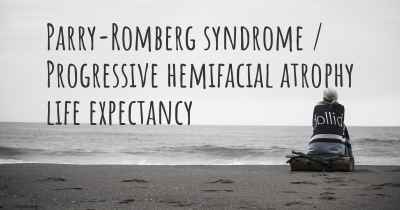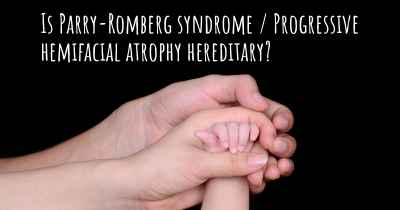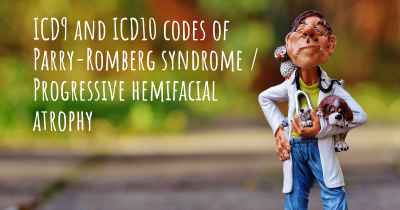What is the history of Parry-Romberg syndrome / Progressive hemifacial atrophy?
When was Parry-Romberg syndrome / Progressive hemifacial atrophy discovered? What is the story of this discovery? Was it coincidence or not?

Parry-Romberg syndrome, also known as progressive hemifacial atrophy, is a rare disorder characterized by the progressive wasting away (atrophy) of the tissues on one side of the face. The condition typically begins in childhood or adolescence and worsens over time. Parry-Romberg syndrome affects both males and females of all ethnic backgrounds.
Historical Background:
The syndrome was first described by Caleb Hillier Parry, an English physician, in 1825. Parry observed a case of facial atrophy in a young woman and documented the clinical features of the condition. However, it was not until 1846 that Moritz Heinrich Romberg, a German neurologist, provided a more comprehensive description of the disorder and coined the term "progressive hemifacial atrophy."
Clinical Presentation:
Parry-Romberg syndrome typically begins with subtle changes on one side of the face, such as slight wasting of the skin, fat, and muscle tissues. Over time, these changes progress and become more noticeable. The atrophy can affect various structures, including the skin, subcutaneous tissues, muscles, and bones of the face.
Common symptoms include:
- Facial asymmetry: The most prominent feature of Parry-Romberg syndrome is the uneven appearance of the face, with one side showing progressive atrophy.
- Skin changes: The affected side may develop hyperpigmentation, thinning, and tightness of the skin.
- Loss of fat and muscle: The wasting of subcutaneous fat and facial muscles can lead to sunken cheeks, deepening of facial lines, and a hollowed appearance.
- Dental and ocular abnormalities: Some individuals may experience dental malocclusion, changes in tooth eruption, and eye abnormalities such as enophthalmos (sunken eye).
- Neurological symptoms: In some cases, Parry-Romberg syndrome may be associated with neurological manifestations, including seizures, migraines, and sensory disturbances.
Possible Causes:
The exact cause of Parry-Romberg syndrome remains unknown. However, several theories have been proposed, including:
- Autoimmune dysfunction: Some researchers believe that the condition may be triggered by an autoimmune response, where the body's immune system mistakenly attacks the tissues on one side of the face.
- Vascular abnormalities: Another hypothesis suggests that abnormalities in the blood vessels supplying the affected side of the face may contribute to the development of the syndrome.
- Genetic factors: There is evidence to suggest that genetic factors may play a role in Parry-Romberg syndrome, as it occasionally occurs in families and has been associated with certain genetic markers.
- Neurological involvement: The involvement of the trigeminal nerve, a major cranial nerve responsible for facial sensation and motor control, has also been proposed as a potential factor.
Diagnosis and Management:
Diagnosing Parry-Romberg syndrome can be challenging due to its rarity and variable presentation. A thorough medical history, physical examination, and imaging studies such as magnetic resonance imaging (MRI) may be used to evaluate the extent of facial atrophy and rule out other conditions.
As there is currently no cure for Parry-Romberg syndrome, treatment focuses on managing the symptoms and improving quality of life. Various approaches may be employed, including:
- Surgical interventions: Reconstructive procedures, such as fat grafting, dermal fillers, or bone grafting, may be considered to restore facial symmetry and volume.
- Orthodontic and dental treatments: Dental abnormalities can be addressed through orthodontic interventions, such as braces or dental implants.
- Medical therapies: Medications such as corticosteroids, immunosuppressants, or antiepileptic drugs may be prescribed to manage specific symptoms or slow down the progression of the disease.
- Psychological support: Given the potential impact on self-esteem and body image, individuals with Parry-Romberg syndrome may benefit from counseling or support groups.
Prognosis:
The progression of Parry-Romberg syndrome varies among individuals. In some cases, the atrophy stabilizes after a certain point, while in others, it may continue to progress over many years. The condition is generally not life-threatening, but its impact on physical appearance and associated symptoms can significantly affect an individual's quality of life.
Conclusion:
Parry-Romberg syndrome, or progressive hemifacial atrophy, is a rare disorder characterized by the progressive wasting away of tissues on one side of the face. Although the exact cause remains unknown, the condition has been associated with autoimmune dysfunction, vascular abnormalities, genetic factors, and neurological involvement. Diagnosis can be challenging, and treatment focuses on managing symptoms and improving facial symmetry. While Parry-Romberg syndrome may have a variable prognosis, ongoing research aims to deepen our understanding of the condition and develop more effective interventions.








